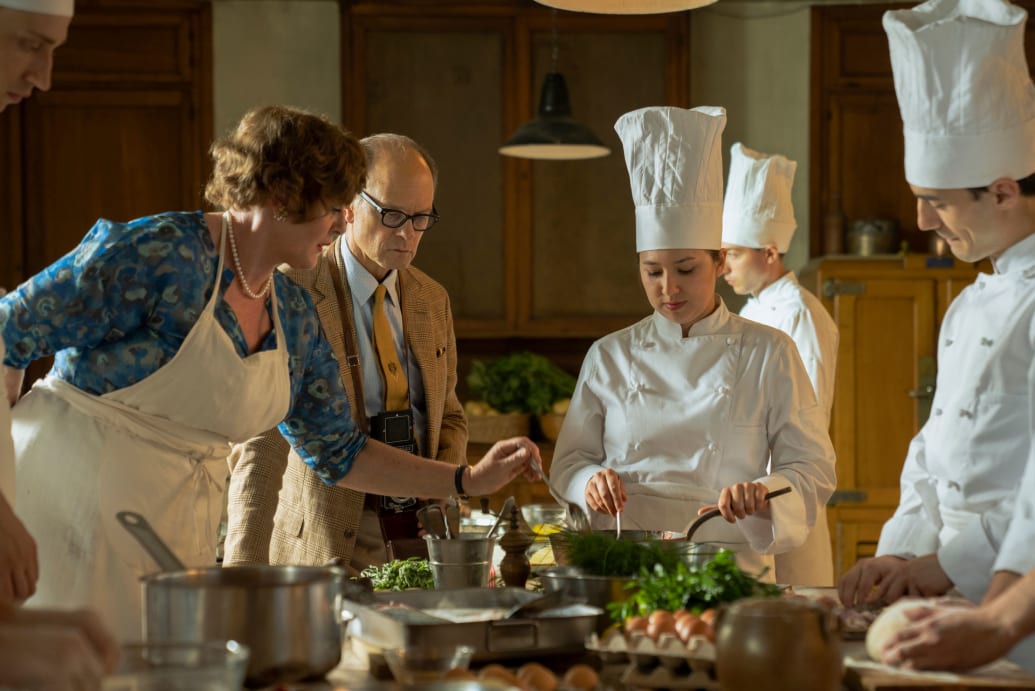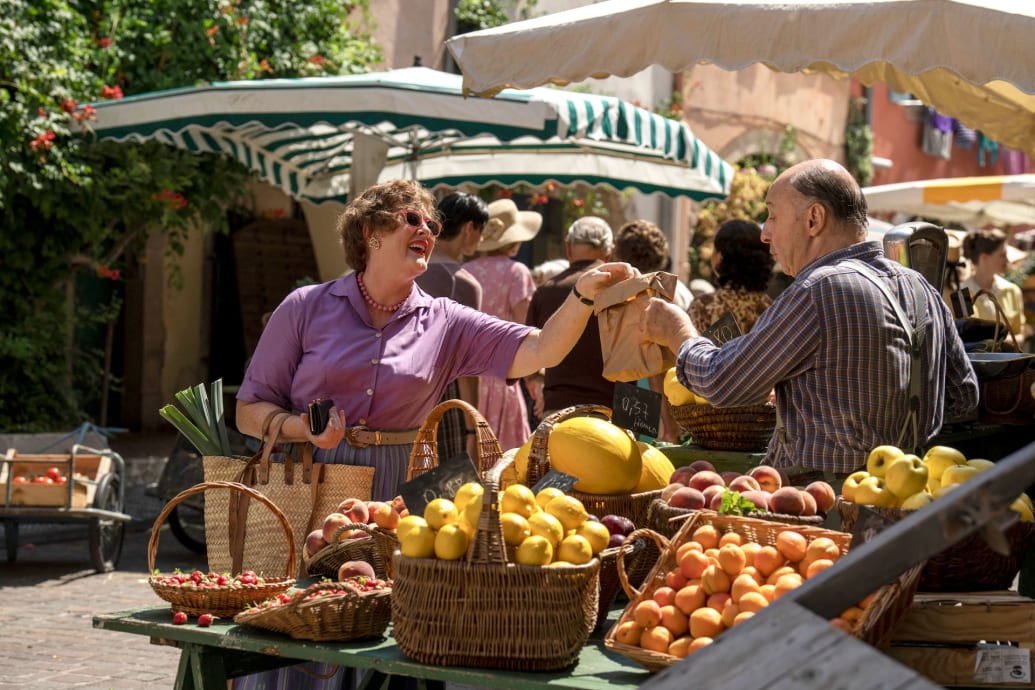[ad_1]
Max’s Julia, which just wrapped its second season, chronicles legendary chef Julia Child (Sarah Lancashire) as she creates the television show, The French Chef, that would bring her international fame. Watching it is a symphony of delights, from seeing the delectable dishes, created with the help of food stylist Christine Tobin (duh) to the loving, horny relationship between Julia and her husband Paul (David Hyde Pierce). Over time, Child has become so steeped in our cultural consciousness that many of her fans know about her time spent in France, which became foundational as she launched her second act as a chef and TV personality (her first career was a researcher for the Office of Strategic Services, the predecessor to the CIA).
But to really get a sense of her life there, as so beautifully dramatized in Julia, we took a culinary dream trip to Paris, and spoke to the creative team behind the series about bringing her time there to life. Now that the season has aired, here’s a look back at how the show pulled off the magical trip.
The first season of Julia established Child’s life in Cambridge, Massachusetts, with Paul, revealing the hoops she had to jump through to get The French Chef on air. Creators Daniel Goldfarb and Christopher Keyser knew they wanted to take Julia to France in Season 2, but needed to figure out the right way to go about it. Season 2’s first episodes show Child working on her second cookbook with Simca (Isabella Rossellini) at their home in the French countryside. But in Episode 3, “Pressed Duck,” the series heads to the City of Lights to show what Julia and Paul’s former life there was like.
As Keyser explains, “We went through a bunch of iterations of this episode. We decided that instead of doing a traditional ‘let’s just go back and relive everything’ [approach], it would be a more specific emotional journey about the question of: What does your past mean? What have you left behind? What did you accomplish? What are you going to do in the future? That freed us up. We wanted not to do what felt like a travelog.”
The emotional journey that Julia and Paul go on takes them to iconic Parisian sites like Le Cordon Bleu, Hotel Plaza Athenee, and Le Grand Vefour, and, of course, includes many incredible views of the Eiffel Tower. Goldfarb says that there were more famous places they initially wanted to include. When Judith Jones (Fiona Glascott) walks past a bookstore, for example, it could have been the iconic Shakespeare and Company shop, but opting to film less famous locations instead allowed for more freedom. “As we got more and more into it, we loved the idea that for all these people that have actually lived in Paris, it was more fun to not do the tourist Paris and to sort of find these little squares and these little streets and park benches,” Goldfarb says.
That isn’t to say there wasn’t a thrill in shooting at an incredibly iconic location like Hotel Plaza Athenee, an famous hotel that originally opened in 1913. Goldfarb says that Julia is the first show to ever receive permission to film in the lobby of the hotel during the day while they still operated, as director Scott Ellis worked his magic. Production designer Patrizia von Brandenstein says that the crew was extremely nervous to shoot at Plaza Athenee, but working with their French crew made it a breeze.
“The French crew was extremely careful because they were used to gorgeous places like this,” von Brandenstein says. “They were very sensitive to the environment. And even though everything is upholstered with silk and satin and beautiful colors, it was not a problem. We posted the balconies for weight, because we knew we were going to be out there with a heavy camera and so forth. [But the crew was] absolutely perfect.”
While Plaza Athenee, as Goldfarb says, “still looks like it did 60 years ago,” other locations that show up in the series have either been modernized or were closed at the time when Julia filmed in August. Le Cordon Bleu looms large in Julia, both physically, when Julia goes on her mission to recreate the dish loup en croute, but also emotionally, as she goes to work with the chef who taught her everything she now knows. According to von Brandenstein, production initially visited Le Cordon Bleu during a scouting trip. “We went to the real place where she had studied and it was very nice but an ordinary building,” she says. “We went to the new Le Cordon Bleu which is so shiny and gleaming and has turned into an enormous school. But it was pointless for us to go there because we needed an old kitchen.”

The crew eventually was told by one of their location scouts to look into Chateau de Ferrand in Saint-Emillion, which had exactly the vintage set up they were looking for. “The time [at Chateau de Ferrand] was very short because we found it and had to film it three days later. These people were marvelous to us. We showed up carrying all our dolls and dishes to drag into their kitchen. They had a perfectly beautiful contemporary kitchen that we didn’t want,” von Brandenstein says. “We wanted the old kitchen because they hadn’t remodeled it or done anything to it. So we had all the half level basement floor. We had ancient cabinets and cupboards and sinks and we brought in stoves and fridges and all the things that one would want for that kind of place.”
The crew had to work similar magic to recreate Le Grand Vefour, a restaurant that the Childs loved. In the episode, Julia and Paul have a lavish dinner with friends that turns grave when they begin talking about how they worked on getting Jewish people resettled in France after the Holocaust. This brings up their old friends, the Rosenthals, and one of their friends said that nothing in France has actually changed. Producers knew that Le Grand Vefour needed to be featured in the episode, as Julia and Paul went there once a month when they lived in Paris. It was also referenced in Episode 8 of Season 1.
But when shooting began on “Pressed Duck” in August, the infamous restaurant was closed for the month Von Brandenstein, then, had to work her magic. “We ended up shooting at a different location at a really marvelous club, an organization that is connected with France and the United States. There are many treaties and diplomats who have gone through that place. It is actually a sort of formal meeting room but quite large. It has a magnificent staircase, very beautiful chairs, and the best moldings of gilt that I have ever seen. I was thrilled to be there and we tried to live up to it.”
“It was a lot of fun because we really had a lot of silver in that place,” she continues. “We had buckets of flowers, which unfortunately, I think one bucket got knocked over in the prep room, and we almost fainted because that was parquet floor and we knew it. There are restrictions at a place like that, but who could pass that up for a location? It was wonderful.”
The emotional conversations that begin at Le Grand Vefour continue through the rest of “Pressed Duck,” including with Julia and Paul talking at a museum. That location is a throwback to Season 1. The museum, von Brandenstein shares, was actually the same set that was built for the White House reception room that’s seen in Episode 7 of Season 2, “Shrimp and Grits.” But the museum isn’t really the focal point—it’s where that conversation between Julia and Paul takes them for the rest of season two as Keyser explains.

“The Paris episode is for Julia and Paul about emotionally the same thing but in different ways,” he says. “For Julia. It’s a conversation about how what she learned in France is a jumping off point for everything she’s going to do in the future. A full embrace of the future based on the skills you’ve learned in the past. And Paul’s is a much darker, more complicated story because it’s a story about what he believed he accomplished after the war in Paris and how it turns out that history didn’t play out the way he might’ve imagined once he leaves. It’s also a conversation about the way in which you end up having to live in the moment and you don’t actually get the chance to bend history.”
While the episode is about Paris and the miraculous beauty of the city, it also is a catalyst for charting the growth of the characters. That’s a big reason why Goldfarb and Keyser didn’t simply want to make a travelog episode, as he says. “A lot of the episode is about meaning and what we did in the past, what it means to us, and how we see it and how we carry that meaning with us into the present and the future. Even though there’s something very melancholy about the episode, Sarah performs it so beautifully at the end of the episode when she says the climax is in the second act. That’s the best part. So they had this weekend of living in the past in the most beautiful magical city in the world to learn from. It is actually to live for the future to look forward, not back.”
[ad_2]